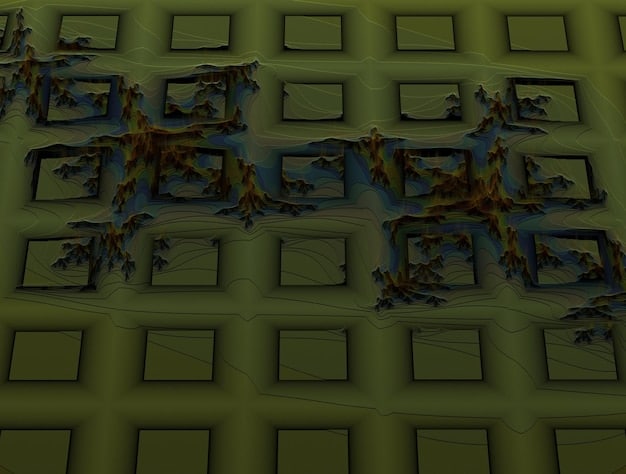Master LoL Vision: Warding Strategies to Avoid Ganks in 2025

Effective ward placement strategies in League of Legends are crucial for controlling vision, anticipating enemy movements, and preventing ganks, providing a significant advantage for your team in securing objectives and winning the game in 2025.
In League of Legends, mastering vision control is paramount to success. This guide dives deep into effective ward placement strategies, empowering you to control vision, anticipate enemy ganks, and secure victory in 2025.
Understanding the Importance of Vision Control in League of Legends
Vision control is often the difference between victory and defeat in League of Legends. Effective warding allows you to track enemy movements, anticipate ganks, secure objectives, and ultimately make informed decisions that lead to a strategic advantage.
Without proper vision, you’re essentially playing in the dark, vulnerable to ambushes and unable to capitalize on opportunities. Let’s delve into the core reasons why vision control is so vital:
Avoiding Ganks and Protecting Your Lane
One of the most immediate benefits of good warding is the ability to avoid ganks. By placing wards in strategic locations around your lane, you can spot the enemy jungler approaching, giving you ample time to react and retreat to safety.
This not only protects you from dying and losing valuable experience and gold but also denies the enemy jungler the opportunity to snowball their advantage. Effective warding effectively turns potential enemy aggression into wasted time for them.
Securing Objectives and Map Awareness
Vision control extends far beyond your lane. Warding around key objectives like dragon, baron, and rift herald allows your team to anticipate enemy attempts to take these objectives. With vision in place, you can contest the objective, steal it, or simply deny the enemy the opportunity to take it uncontested, ultimately dictating the pace of the game.
- Early Game Warding: Focus on defensive wards to avoid early ganks and protect your scaling.
- Mid Game Warding: Transition to offensive wards to track the enemy jungler and secure objective vision.
- Late Game Warding: Prioritize control wards near Baron Nashor and Dragon to secure game-winning advantages.
In essence, mastering vision control is about gathering information. The more information you have about the enemy’s movements and intentions, the better equipped you are to make informed decisions and lead your team to victory.
Mastering Ward Placement: Advanced Techniques for 2025
Simply placing wards isn’t enough; you need to understand where and when to ward to maximize their effectiveness. This section explores advanced ward placement techniques that will help you become a true master of vision control.
Beyond simply placing wards in the river, strategic ward placement involves considering factors such as the game’s stage, your champion’s role, and the enemy team’s composition. Let’s explore some specific techniques:

Deep Warding: Invading Enemy Territory
Deep warding involves venturing into the enemy jungle to place wards. This provides valuable information about the enemy jungler’s movements, allowing you to anticipate ganks, track their farming patterns, and even set up counter-ganks. However, deep warding is inherently risky, so it’s important to consider the following:
Before attempting a deep ward, make sure you have adequate vision around your own lane to avoid being caught out. Also, only attempt deep wards when you have a clear advantage or when you know the enemy jungler’s location.
Defensive Warding: Protecting Your Turf
Defensive warding focuses on protecting your own lane and jungle from enemy incursions. This is particularly important in the early game when you’re most vulnerable to ganks. Effective defensive ward placements include:
- River Bush: The classic ward placement, providing vision of the enemy jungler approaching from the river.
- Tri-Bush: Protects you from ganks from the enemy jungle, especially useful for bot lane.
- Jungle Entrances: Warding the entrances to your jungle helps you track enemy movements and protect your jungler.
Remember to adapt your ward placement based on the specific threats you’re facing. If the enemy jungler is known for early ganks, prioritize defensive wards. If they’re more likely to invade your jungle, focus on warding jungle entrances.
By combining these advanced ward placement techniques with a strong understanding of the game’s flow and your champion’s role, you can elevate your vision control to the next level and gain a significant competitive edge.
Adapting Your Warding Strategy to Different Game Stages
The optimal warding strategy evolves throughout the game. What works in the early game might not be effective in the mid or late game. This section explores how to adapt your warding strategy to each stage of the game.
The early game is often the most vulnerable time, while the late game requires control of key objectives. Let’s break it down:
Early Game (Levels 1-6): Survival and Scaling
Focus on defensive warding to avoid early ganks and protect your scaling. Prioritize warding the river and tri-bush to ensure that you have ample warning of incoming enemy aggression.
Also, be mindful of the enemy support’s roaming potential. If they tend to roam early, consider warding deeper into the river or even around the mid lane to provide your mid laner with additional vision.
Mid Game (Levels 7-12): Objective Control and Tracking the Jungler
Transition to offensive warding to track the enemy jungler and secure vision around key objectives like dragon and rift herald. Deep wards in the enemy jungle can be invaluable for anticipating ganks and setting up counter-ganks.
Late Game (Levels 13+): Securing Victory
Prioritize control wards near Baron Nashor and Elder Dragon to secure game-winning advantages. Vision around these objectives is crucial for contesting them and denying the enemy the opportunity to snowball their lead.
- Early Game: Defensive wards, river and tri-bush priority.
- Mid Game: Offensive wards, tracking the enemy jungler, objective control.
- Late Game: Control wards, Baron and Elder Dragon priority, team coordination.
Remember that communication is key. Coordinate with your team to ensure that you have comprehensive vision coverage across the map. Share information about enemy movements and ward placements to maximize your team’s awareness.
Utilizing Control Wards for Maximum Impact
Control wards, formerly known as pink wards, are an essential tool for maintaining vision control and denying enemy vision. They provide permanent vision in an area and disable enemy wards, but they can be destroyed. This section explores how to use control wards effectively.
Strategic placement, team coordination, and awareness of enemy positioning are crucial for maximizing their impact.
Strategic Placement of Control Wards
Placement is key to maximizing the effectiveness of control wards. Consider the following locations:
Brush is an excellent location for control wards, as they can provide vision of the surrounding area while remaining hidden from enemy view. Also, control wards in close proximity to objectives such as dragon, baron, and rift herald offer crucial information and allow your team to contest these objectives effectively.
Denying Enemy Vision
One of the primary benefits of control wards is their ability to disable enemy wards. When you spot an enemy ward, use a control ward to disable it, denying the enemy vision and potentially opening up opportunities for ganks or objective control.

Remember that control wards are not invincible. The enemy team will often prioritize destroying your control wards, so be prepared to defend them if necessary. Coordinate with your team to provide cover for your control wards and ensure that they remain in place for as long as possible.
By mastering the art of control ward placement and usage, you can significantly enhance your team’s vision control and gain a decisive advantage in League of Legends.
Team Communication and Vision Coordination
Vision control is a team effort. Effective communication and coordination are essential for maximizing the impact of your warding strategy. This section explores how to communicate with your team about ward placements, enemy movements, and potential threats.
Sharing information, coordinating ward placements, and adapting to enemy movements are all critical aspects of successful vision control. The following are key to effective team communication:
Sharing Information About Enemy Movements
Communicate enemy movements and ward placements to your team in real-time. This allows your teammates to react accordingly, avoid ganks, and capitalize on opportunities.
Use pings to alert your teammates to potential threats or opportunities. If you spot the enemy jungler approaching your lane, ping a warning to alert your teammates. If you see the enemy mid laner roaming, ping to let your teammates know.
Coordinating Ward Placements
Coordinate with your team to ensure that you have comprehensive vision coverage across the map. Avoid placing wards in the same location as your teammates, as this is redundant and wastes valuable resources.
- Communicate: Share information about enemy movements and ward placements.
- Coordinate: Ensure comprehensive vision coverage across the map.
- Adapt: Adjust warding strategy based on game conditions.
Adapt your warding strategy based on the specific threats you’re facing. If the enemy team is heavily focused on ganking, prioritize defensive wards to protect your carries. If they’re more likely to invade your jungle, focus on warding jungle entrances.
By fostering a culture of open communication and coordination within your team, you can transform your warding strategy from a solo effort into a powerful team-wide asset. This leads to increased map awareness, improved decision-making, and ultimately, a higher chance of victory.
Common Warding Mistakes and How to Avoid Them
Even experienced players can fall into common warding traps. Recognizing these mistakes and learning how to avoid them are critical for improving your vision control.
Ignoring vision, failing to adapt, and placing ineffective wards are common pitfalls that can undermine your efforts and leave your team vulnerable.
Ignoring Vision Control
One of the biggest mistakes players make is simply ignoring vision control altogether. They might focus on farming, trading, or teamfighting without paying any attention to warding or denying enemy vision.
Ignoring vision control is essentially playing blind, making you vulnerable to ganks, ambushes, and objective steals. Make vision control a priority in every game, even if it means sacrificing some farm or trading opportunities.
Failing to Adapt
Another common mistake is failing to adapt your warding strategy to the changing game conditions. What works in the early game might not be effective in the mid or late game. Similarly, a warding strategy that works against one team composition might not work against another.
- Don’t Ignore: Make vision control a priority in every game.
- Adapt: Adjust your warding strategy to changing game conditions.
- Don’t Place: Avoid ineffective ward placements.
Placement is key to maximizing the effectiveness of your wards. Avoid placing wards in predictable locations or in areas that are easily swept by the enemy. Instead, focus on placing wards in strategic locations that provide valuable information about enemy movements and objective control.
By identifying and correcting these common warding mistakes, you can significantly improve your vision control and gain a competitive edge in League of Legends. Effective warding is not just about placing wards; it’s about understanding the game, adapting to changing conditions, and making informed decisions that lead to victory.
| Key Point | Brief Description |
|---|---|
| 🛡️ Defensive Warding | Protects lanes from ganks, focusing on river and tri-bush wards. |
| ⚔️ Offensive Warding | Tracks enemy jungler, secures vision around objectives. |
| 👁️ Control Wards | Provide permanent vision, disabling enemy wards. |
| 🤝 Team Communication | Share information about enemy movements and ward placements. |
Frequently Asked Questions
▼
In the early game, focus on defensive wards in the river and tri-bush to protect against ganks. These wards will give you early warning of the enemy jungler’s approach.
▼
Use deep wards in the enemy jungle to track their movements. Also, pay attention to which buffs they start with and when they gank to infer their pathing.
▼
Place control wards in strategic locations near objectives or in key pathways to provide permanent vision and deny enemy warding. Defend them to maintain vision dominance.
▼
Vision control allows your team to make informed decisions, avoid ganks, secure objectives, and control the map. This leads to a strategic advantage and a higher chance of victory.
▼
Avoid ignoring vision control, failing to adapt your warding strategy, and placing ineffective wards in predictable locations. Stay proactive with vision.
Conclusion
Mastering **effective ward placement strategies** is essential for climbing the ranks in League of Legends 2025. By understanding the importance of vision control, adapting your warding strategy to different game stages, and communicating effectively with your team, you can gain a significant competitive edge and lead your team to victory.





